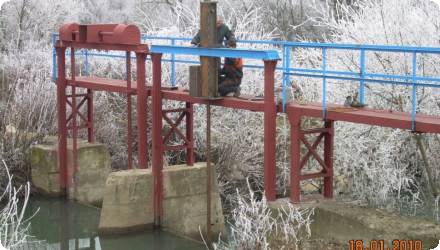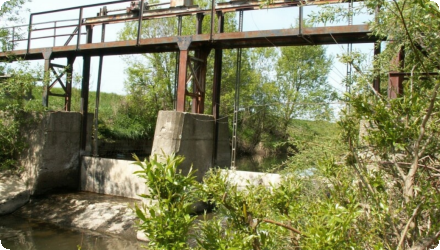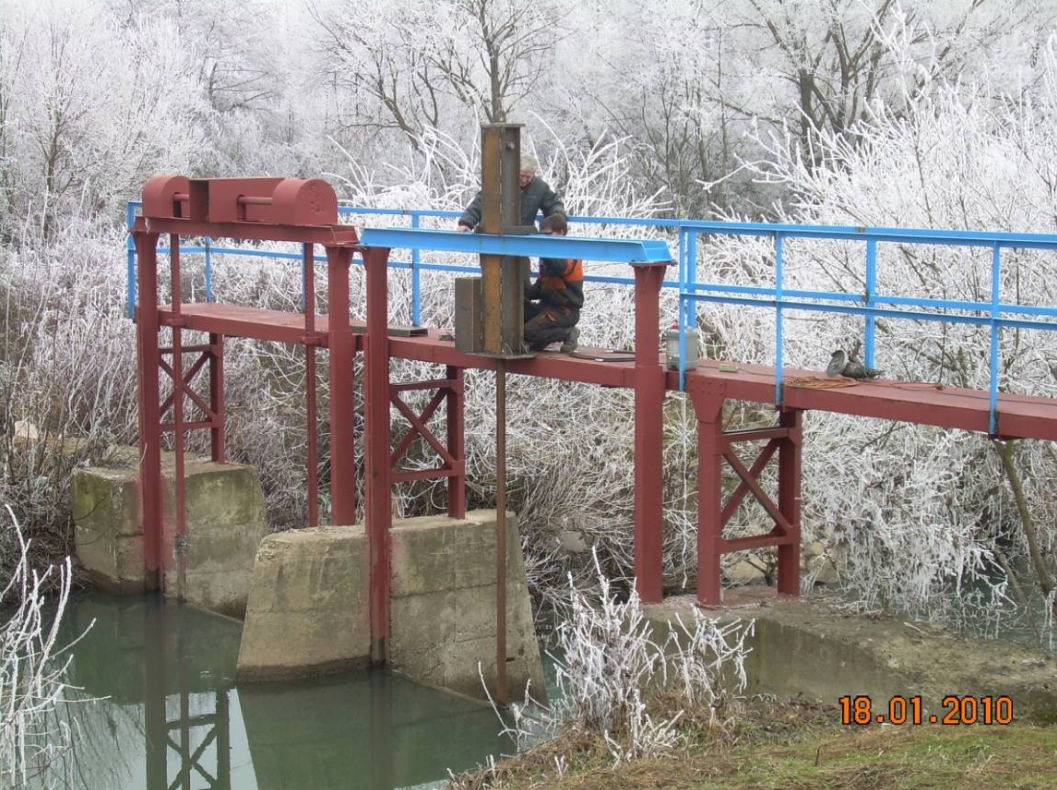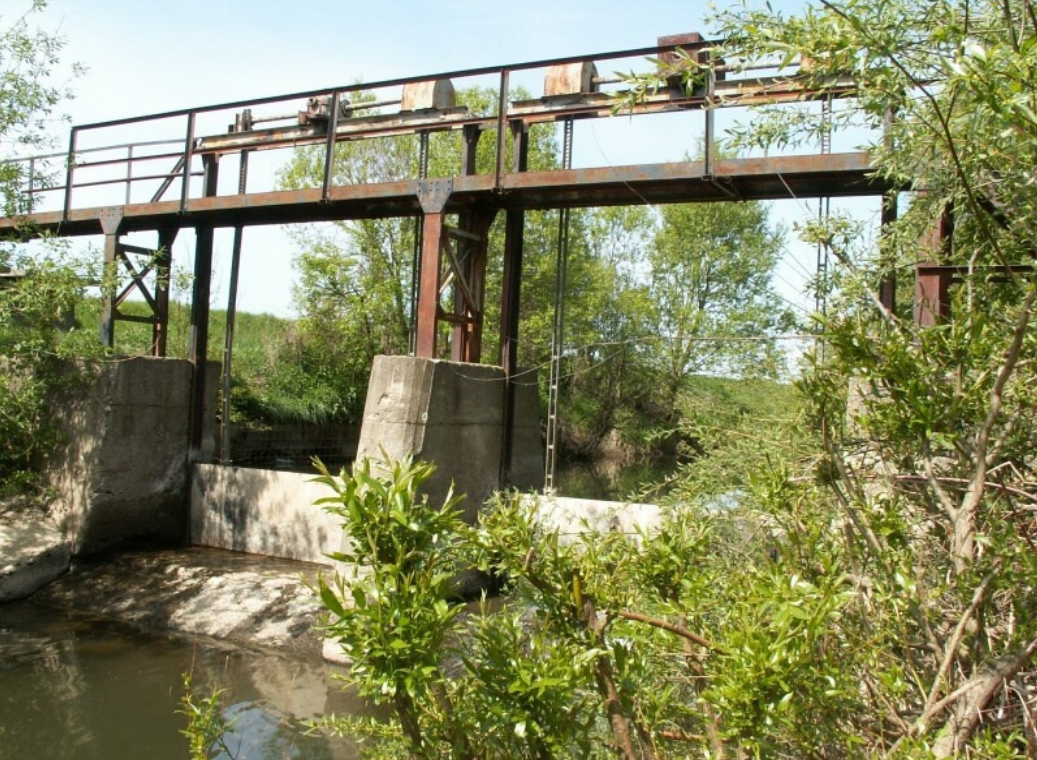Last update
2025
Summary
Originally implemented under the UNDP/GEF Tisza MSP, the measure rebuilt an existing floodgate at the confluence of a drying bypass channel and the Žiarovnický stream in the Senné depression (Bodrog basin). The gate enables gravity supply to the Senné fishponds NNR in dry periods and during floods, and reduces discharges to the Stretávka pumping station. It was financed by the Global Environment Facility and delivered by Global Water Partnership Slovakia with local authorities.
Since then, complementary works have expanded upkeep and control of the small-hydraulic network. A LIFE project for the Senné & Medzibodrožie SPAs restored water-level control via gates/sluices and dyke repairs, improving the hydrological regime around the ponds and Ostrovik meadows.
Most recently (2020–2023), SOS/BirdLife Slovakia repaired/maintained ~1.69 km of dikes and ~2.17 km of supply canals and improved the water regime across ~814 ha; managers now manipulate existing stavidla annually to sustain wetland habitats. These actions and targets are embedded in the 2022 Care Programme for the SPA.
Since then, complementary works have expanded upkeep and control of the small-hydraulic network. A LIFE project for the Senné & Medzibodrožie SPAs restored water-level control via gates/sluices and dyke repairs, improving the hydrological regime around the ponds and Ostrovik meadows.
Most recently (2020–2023), SOS/BirdLife Slovakia repaired/maintained ~1.69 km of dikes and ~2.17 km of supply canals and improved the water regime across ~814 ha; managers now manipulate existing stavidla annually to sustain wetland habitats. These actions and targets are embedded in the 2022 Care Programme for the SPA.
Position
Latitude
48.668
Longitude
22.0794
Project
NWRM
National Id
Slovakia_04
Installation date
2009-12
Implementation Status
Contact
Jovanka Ignjatovic
RBD code
SK40000
Transboundary
1
Photo gallery
Location of the project
In the Senné depression (East Slovak Plain), within the Senné fishponds SPA/NNR area between the villages of Senné, Iňačovce, Blatná Polianka and Blatné Remety.
NUTS Code
SK04 - Východné Slovensko
Project's objectives
Increase the area temporarily flooded by 20%.
Rebuild and operate a floodgate at the confluence of a drying bypass channel with the Žiarovnický stream to supply the Senné wetlands (NNR/fishponds) in dry periods and during floods.
Reduce flood risk locally by decreasing discharges to the Stretávka pumping station and retain water on the designated floodplain/within the NNR (“make space for water”).
Contribute to the Bodrog basin flood-risk strategy by testing a small, quickly deliverable intervention as part of the UNDP/GEF Tisza MSP demo actions.
Rebuild and operate a floodgate at the confluence of a drying bypass channel with the Žiarovnický stream to supply the Senné wetlands (NNR/fishponds) in dry periods and during floods.
Reduce flood risk locally by decreasing discharges to the Stretávka pumping station and retain water on the designated floodplain/within the NNR (“make space for water”).
Contribute to the Bodrog basin flood-risk strategy by testing a small, quickly deliverable intervention as part of the UNDP/GEF Tisza MSP demo actions.
Involved Partners
| Authority type | Authority name | Role | Comments |
|---|---|---|---|
Climate zone
cool temperate moist
Temperature
9
Precipitation
603
Annual rainfall range
600 - 900 mm
Runoff coefficient
0,349999994039536
Elevation range
100
Slope range
2-5%
Vegetation class
Permanent grasslands (TTP) dominate the SPA (≈66% of area), with extensive emergent wetland vegetation (reed and cattail stands) around/in the fishponds; wet meadows and macrophyte stands are key habitat elements.
Water bodies: Ecological Status
Moderate
Water bodies: Chemical Status
Failing to achieve good
Water quality status
The quality of Čierna voda (and Laborec) in this area is reported as influenced by intensive agriculture and fertiliser use—i.e., nutrient pressure.
Project scale
Micro
Project scale specification
The measure is the reconstruction of a single floodgate at the confluence of a bypass channel and the Žiarovnický stream in the Senné depression, to control local wetland water levels and reduce discharges to the Stretávka pumping station.
Performance timescale
< 1 year
Project area
25100
Area subject to Land use change or Management/Practice change (ha)
25100
Lifespan
50
Design capacity description
Reconstruction of existing floodgate
Missing harmonization of national strategies and unsatisfactory involvement of stakeholders and NGOs
There is a pumping station with 16m3/s capacity from a previous project
Total cost
€45,234
Costs total information
Slovakian project site: Preparation of the strategy + Restoration of the original floodplains + Dissemination of project results + Project managements
Costs investment
28720
Costs investment information
Slovakian project site: Preparation of the strategy + Restoration of the original floodplain
Costs capital
19745
Costs capital information
Slovakian project site: Restoration of the original floodplains
Economic costs other annual
46670
Information on Economic costs other annual
Rest of the project:Hungarian(39490) and Ukranian(7180) sites; (TOTAL = 91904)
Administrative annual costs
4667
Financing authorities
Type of funding
Other
Type of funding
Local funds
Type of funding
Private funds
Compensations
0
Policy context
Reduced area of natural floodplain, declining biodiversity; water quality-affected by point and diffuse sources of pollution (agriculture, chemical production, urban effluents); insufficient water management regarding flood prevention and protection; missing harmonization of national strategies on flood management and flood prevention within Bodrog river Basin.
Land ownership
The fishpond system in the Senné depression was privatised in 2000, but theowner does not own many of the underlying plots; the area has many small landowners.
Community involvment
Yes
Design consultation activity
| Activity stage | Name | Key issues | Comments |
|---|---|---|---|
|
Common Meetings
|
Organised by the project
|
||
|
Design phase
|
Coordination meetings
|
Activities at national level
|
Organised by the project partners or participation of the project expert on the events at national level
|
|
Other
|
Dissemintaion activities
|
To achieve replication on national levels and to other basins
|
This activities included: meetings with international stakeholders, inforamation materials and interview for informing the media, articles for local newspapers and presentations about the results of the project at local and international meetings
|
Policy target
| Target purpose |
|---|
|
Increase Water Storage
|
|
Pollutants Removal
|
Policy pressure
| Pressure directive | Relevant pressure |
|---|
Policy impact
| Impact directive | Relevant impact |
|---|
Requirement directive
| Requirement directive | Specification |
|---|
Contractual arrangements
1
| Arrangement type | Responsibility | Role | Name | Comments |
|---|---|---|---|---|
|
Contractual agreement
|
Establish the bases of the transboundary cooperation.
|
Committes for transboundary water
|
Bilateral agreement between Slovakia and Hungary. Main force to arrange the flood prevention in Bodrog River Basin.
|
|
|
Other
|
Towards a River Basin Management Plan for the Tisza River supporting sustainable development of the region
|
Memorandum of Understanding between the riparian ministries
|
||
|
Contractual agreement
|
Contracts
|
Signed by GWP and each partner on undertaking specific tasks
|
Part of wider plan
1
Wider plan type
| Wider plan type | Wider plan focus | Name | Comments |
|---|---|---|---|
|
National
|
Water
|
UNDP/GEF MSP project Component 1, activity 1(ii)
|
Component 1 of the Project: Making space for water in the Bodrog river Basin
|
|
National
|
Water
|
Program of Flood Protection Measures of the Slovak Republic until 2010
|
The program has declared the restoration of original function of water courses and the improvement of aquatic and terrestrial environment, especially in lowland areas by a long-term flood protection plan oriented predominantly at water retention measures with the aim to decrease surface runoff and maximum discharges.
|
|
National
|
Water
|
National mitigation strategy and plan focused on flood management and flood prevention.
|
Each country (SK-HU-UA) within the Tisza catchment has developed it
|
|
National
|
Water
|
Related Iniciatives
|
Project "MOSES - Improvement of flood management in Slovakia and Ukraine"; Project UNDP/GEF"Integration of Ecosystem Management Principles and Practices into Land and Water Management of Laborec-Uh region"; Project LIFE "Conservation of Senne and Medzibodrozie SPAs in Slovakia".
|
Regular monitoring of key bird species and wetland habitats is required, with stable breeding-season water levels and data entered in national databases.
Counts of calling males/nesting pairs for target species (e.g., great bittern, ferruginous duck); extent and condition of habitats (reed/cattail stands, wet meadows); presence/pressure of predators; and management outcomes linked to water-level manipulation.
Maintenance
Ongoing maintenance consists of repairing and operating sluices and dikes, revitalising canals, and managing vegetation (mowing/grazing) to sustain appropriate water levels.
Catchment outlet
Quarterly reports, partly achieved at the end of the project, fully by year 1 after the end, applied to: strategy for mitigation of floods, change of land use and measures elaborated to reduce the effects of floods, to reflect the basin and habitat improved conditions (related to water regime and quality, agiculture, forestry, etc.)
Formulation of the "Strategy for mitigation of floods for Bodrog River Basin countries" Creation of "rooms for water" improving the conditions of original floodplains and wetlands affected by current land uses and environmentally inappropriate flood protection measures.
The project team promoted agri-environment schemes (AES) throughout implementation, offering free advisory services; 33 land users attended AES training, and farmers in the area entered AES during the programming period.
The project team promoted agri-environment schemes (AES) throughout implementation, offering free advisory services; 33 land users attended AES training, and farmers in the area entered AES during the programming period.
By the Strategy, a framework for effective creation of new temporary space for water during flood event swill be set up for each country. Replication on national levels and to other basins thanks to the dissemination of the project results.
Information on increased water storage
Intervention reduces flood risks by decreasing of water discharge into Stretavka pumping station and simultaneously allows retention of water into NNR.
Subsequent works (2020–2023, LIFE IPORSEN) repaired/maintained ~1,690 m of dikes and ~2,170 m of supply canals, improving the water regime over ~814 ha (NNR + production ponds + Ostrovik meadow). Managers manipulate existing sluices annually to keep levels. A 600 m dike on Ostrovik now enables simulated inundation.
Subsequent works (2020–2023, LIFE IPORSEN) repaired/maintained ~1,690 m of dikes and ~2,170 m of supply canals, improving the water regime over ~814 ha (NNR + production ponds + Ostrovik meadow). Managers manipulate existing sluices annually to keep levels. A 600 m dike on Ostrovik now enables simulated inundation.
1
The site maintains regular breeding of Great Bittern and Ferruginous Duck (typically 1–3 pairs/booming males; 10–30 individuals for ferruginous duck).
In 2023, a new breeding bird species for Slovakia (glossy ibis) was recorded at Senné; works are cited as improving conditions for rare waterbirds.
In 2023, a new breeding bird species for Slovakia (glossy ibis) was recorded at Senné; works are cited as improving conditions for rare waterbirds.
Ecosystem impact climate regulation
Not relevant for the specific application
Key lessons
A first, enduring lesson is about process: success depended on long-term, hands-on work with local stakeholders and on showing the practical advantages of alternatives; even small, well-chosen measures delivered noticeable improvements.
Design flexibility was essential. An intended reconstruction on the Cibavka channel had to be dropped after some farmers objected; the team pivoted to refurbish the floodgate at the main drainage channel/Žiarovnica confluence instead. That low-tech fix (by SVP in Dec 2009) came with an operational manual and still achieved the goals of supplying the reserve during dry periods and reducing discharges to the Stretávka pumping station.
Plan works around ecology. During the 2023 LIFE IPORSEN phase, dyke repairs and inlet-canal cleaning were scheduled after the breeding season to limit disturbance, with the expected benefit of improving the water regime across “over a thousand hectares” of wetlands while also protecting adjacent farmland from unwanted flooding.
Ownership and governance matter. The area mixes a state nature reserve, a privately operated fishpond complex (privatised in 2000), and many small landowners—creating real coordination challenges. The NWRM case flags fragmented ownership as a barrier, and the CHVÚ management plan documents the fishpond operator’s role and intensification since privatisation—underscoring the need to align nature protection, water management and aquaculture.
Make the most of existing infrastructure. The local melioration network—once built to drain wetlands—can be run “in reverse” to hold water, and modest gate/levee fixes plus channel cleaning can deliver catchment-scale ecological gains. Recent municipal micro-projects (e.g., “Čierna voda ožíva”: reconstructing a levee culvert to re-wet 1.9 ha by gravity) show how these small interventions can keep adding value.
Finally, continuity breeds impact. The 2009–2011 pilot (GEF/UNDP, ICPDR) set the template; subsequent LIFE IPORSEN works (2021–2023) and parallel cross-border “BirdTour” investments in visitor infrastructure built local support and helped sustain wetland management.
Design flexibility was essential. An intended reconstruction on the Cibavka channel had to be dropped after some farmers objected; the team pivoted to refurbish the floodgate at the main drainage channel/Žiarovnica confluence instead. That low-tech fix (by SVP in Dec 2009) came with an operational manual and still achieved the goals of supplying the reserve during dry periods and reducing discharges to the Stretávka pumping station.
Plan works around ecology. During the 2023 LIFE IPORSEN phase, dyke repairs and inlet-canal cleaning were scheduled after the breeding season to limit disturbance, with the expected benefit of improving the water regime across “over a thousand hectares” of wetlands while also protecting adjacent farmland from unwanted flooding.
Ownership and governance matter. The area mixes a state nature reserve, a privately operated fishpond complex (privatised in 2000), and many small landowners—creating real coordination challenges. The NWRM case flags fragmented ownership as a barrier, and the CHVÚ management plan documents the fishpond operator’s role and intensification since privatisation—underscoring the need to align nature protection, water management and aquaculture.
Make the most of existing infrastructure. The local melioration network—once built to drain wetlands—can be run “in reverse” to hold water, and modest gate/levee fixes plus channel cleaning can deliver catchment-scale ecological gains. Recent municipal micro-projects (e.g., “Čierna voda ožíva”: reconstructing a levee culvert to re-wet 1.9 ha by gravity) show how these small interventions can keep adding value.
Finally, continuity breeds impact. The 2009–2011 pilot (GEF/UNDP, ICPDR) set the template; subsequent LIFE IPORSEN works (2021–2023) and parallel cross-border “BirdTour” investments in visitor infrastructure built local support and helped sustain wetland management.
Success factor(s)
| Success factor type | Success factor role | Comments | Order |
|---|---|---|---|
|
Attitude of relevant stakeholders
|
secondary factor
|
<p>The measures can be done in a short period of time (within 12 months)</p>
|
1
|
Driver
| Driver type | Driver role | Comments | Order |
|---|---|---|---|
|
Past flooding events
|
main driver
|
Yearly in the Bodrog catchment area which have negative consequences on inhabitants. Most serious one was in 2004 when floods affected 75% of the area in Eastern lowlands, managed by Water Management enterprise and also inhabitants had to be evacuated.
|
1
|
|
Availability of subsidies
|
secondary driver
|
Without the UNDP/GEF support, the coordination among the Bodrog River Basin countries and the national plans and their implementation on the local level would be very limited and thus the idea of flood prevention through the integrated land and water management would not be implemented.
|
2
|
Transferability
Highly transferable to lowland wetlands with existing drainage canals: simple gate/levee repairs can restore seasonal retention and habitat. Success hinges on early stakeholder work and flexible design. Check legal water rights, ownership fragmentation, fishpond/operator interests, reliable inflow, and breeding-season timing; plan ongoing operation/maintenance and monitoring.
English



